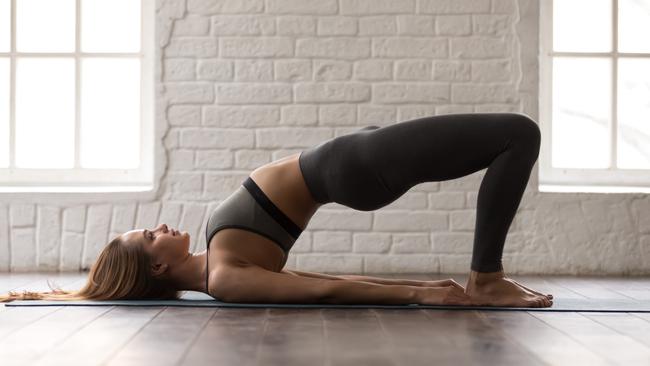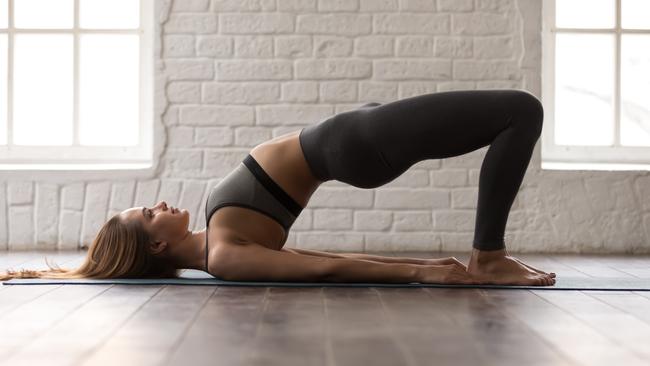The lazy person’s workout
Research suggests that performing small exercises as you go about your day can make a big difference to your physical tone.

The problem with exercise is that it takes so much time and effort. For many, the stress of getting to the gym, let alone doing a workout, is the game changer that means your goals are ultimately doomed. But what if there were fitness gains to be made from doing nothing much at all?
Exercise involving minimal movement may sound like a waste of time but experts say even the most subtle techniques can make all the difference to your health and fitness.
“There is a lot that you can do to improve your strength and posture without working out,” says Neil Dimmock, head of fitness at Ten Health & Fitness studios in London. “If we are conscious about our muscles and movement throughout the day, it can pay off significantly.”
From buttock clench to shoulder shrug, here’s how to do it:
Suck in your stomach

It looks bizarre, but hollowing out and sucking in — or vacuuming — your stomach can help you to get an impressively flat and toned torso. Experts say it activates the transverse abdominis, the muscle that wraps around the torso and acts like a corset on the midsection.
Dalton Wong, the director of Twenty Two Training and fitness adviser to actresses Jennifer Lawrence and Olivia Colman, recommends his clients do it for at least a minute every day.
It’s best performed sitting or standing in a bent-over position; the idea is to breathe in deeply and exhale forcefully as you suck in your belly button towards your spine. Hold the contraction (but not your breath) for 20 to 60 seconds, relax and repeat three times.
Physiotherapist Sammy Margo says she has known people to knock inches from their middle by doing stomach vacuuming.
“It’s one of the best and certainly the most subtle exercises you can do to reduce your waistline quickly.” It’s not without controversy and shouldn’t be performed if you have low blood pressure or breathing problems.
Squeeze your glutes
There are two simple ways to do this. The first is by doing the sort of bridge exercise you may perform on a mat in a Pilates class; the second is by just squeezing your buttock muscles as you sit or stand.
For a study published last month in PeerJ — the Journal of Life and Environmental Sciences, exercise scientists at Wichita State University in the US put both methods to the test. In the trial, 32 students were randomly assigned to perform 15 minutes of gluteal squeezes a day — which required them to sit up straight and squeeze their glutes as hard as they could for five seconds before relaxing and repeating — or glute bridges, for which they had to lie on the floor and squeeze their glutes to raise their hips, so that their body formed a straight line from knees to shoulders. They didn’t need to do them all in one go; participants could do the exercises in bouts adding up to 15 minutes each day.

After eight weeks results showed that all of the subjects had made similar improvements in tests of muscle endurance and jumping power. Surprisingly, though, those who had performed the slightly easier gluteal squeeze had increased their gluteal or hip extension strength by 16 per cent, compared with an 11 per cent improvement for those doing the glute bridge exercise.
The researchers concluded that there are “clinical and aesthetic reasons to perform gluteal squeezes” because the girth of the glute muscles also increased more significantly in the squeeze group. Good technique matters. In the study, the subjects were instructed to sit so that hips and knees were at right angles, with knees shoulder-width apart and the feet touching.
Shrug your shoulders
Tension builds in the neck and shoulders as you hunch over a keyboard or steering wheel, and if you don’t have time for a yoga class then you can help to reset your posture with shoulder shrugs throughout the day. Chiropractor David Phillips says they are a good way prevent muscular pain from building: “It’s a movement that improves circulation and can leave you feeling more flexible and relaxed. They encourage your body to release muscular tension.”
Performed sitting or standing, the idea is to raise your shoulders towards your ears and back down 10 times, then revolve the shoulders in forward circles 10 times and backward circles 10 times.
“The key thing is that you are moving the shoulders in different ways,” Phillips says. “Repeat this several times a day.”
‘Unconsciously competent’ muscles
No prizes for guessing that this is a phrase doing the rounds in gyms across Los Angeles and New York.
It refers to frequent engagement of the deeper abdominal muscles in every day activities, even when you are slobbing on the sofa or slouching at your desk, so they become stronger and better able to support your body. Dimmock says it’s hugely important.
“Your core doesn’t consist of one muscle but several that work together to perform functional movement,” he says. “The activation of the deeper unit of muscles, including the transversus abdominis, is one of the principles of Pilates and something we should think about doing frequently throughout the day to become stronger.”
To purposely engage these muscles takes practice.
“It’s easier to switch on the core when the diaphragm expels air from the body, or when you exhale,” Dimmock says. “As you do this, draw navel to spine, as the navel is where the transverse abdominis is situated, then hold briefly before releasing. It’s not healthy to keep your core tight for a prolonged period. You need to release tension after a while so waste products can be expelled before contracting briefly again.”
Repeat throughout the day.
Try the one stretch
Studies from the University of Arkansas show about 50 per cent of people experience back pain after prolonged periods of standing in queues, at concerts or at work — even at a standing desk.
When we stand, we subconsciously relax into poor posture with feet rolled inwards, shoulders rounded and tummy sticking out.
“Ultimately this can lead to pain in the lower back,” Margo says. Think about standing as tall as you can and try performing the One Stretch for better back health. One Japanese study found that daily practice of this movement reduced lower back pain in workers.
To do it, stand with feet shoulder-width apart and place your hands firmly on your lower back, fingers pointing to the floor. Breathe in, then exhale for three seconds as you gently stretch backwards, keeping the legs straight. Keep your hands in place as you return to the start position and repeat several times a day.
Have a laugh
German researchers examined whether laughter resulted in “an increased demand on trunk muscles”, providing a good workout for the core. They compared the activation level of five trunk muscles when people laughed (during a laughter yoga class) with how hard the same muscles worked while performing traditional crunch and back lifting exercises.
They found that activation of the external oblique muscles, which extend from the lower half of the ribs around and down to the pelvis on each side of the trunk, was the same for both. Other trunk muscles — including the multifidus, erector spinae and rectus abdominis muscles — were activated about half as much during laughter compared with when subjects performed exercises.
Dimmock says coughing has a similar effect: “In our Pilates classes we will ask people to cough, as it triggers the deep abdominal muscles to tighten. When you laugh or cough you breathe out and that switches on the core muscles.”
The Times



To join the conversation, please log in. Don't have an account? Register
Join the conversation, you are commenting as Logout